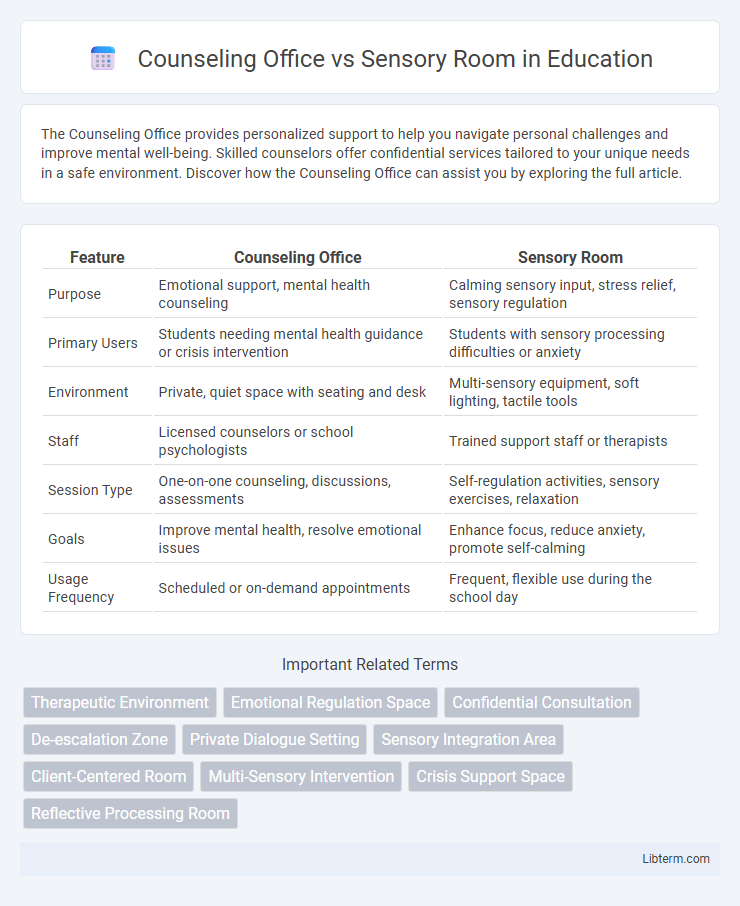The Counseling Office provides personalized support to help you navigate personal challenges and improve mental well-being. Skilled counselors offer confidential services tailored to your unique needs in a safe environment. Discover how the Counseling Office can assist you by exploring the full article.
Table of Comparison
| Feature | Counseling Office | Sensory Room |
|---|---|---|
| Purpose | Emotional support, mental health counseling | Calming sensory input, stress relief, sensory regulation |
| Primary Users | Students needing mental health guidance or crisis intervention | Students with sensory processing difficulties or anxiety |
| Environment | Private, quiet space with seating and desk | Multi-sensory equipment, soft lighting, tactile tools |
| Staff | Licensed counselors or school psychologists | Trained support staff or therapists |
| Session Type | One-on-one counseling, discussions, assessments | Self-regulation activities, sensory exercises, relaxation |
| Goals | Improve mental health, resolve emotional issues | Enhance focus, reduce anxiety, promote self-calming |
| Usage Frequency | Scheduled or on-demand appointments | Frequent, flexible use during the school day |
Introduction to Counseling Offices and Sensory Rooms
Counseling offices provide a confidential space where individuals receive psychological support and guidance from trained professionals, addressing emotional, behavioral, and mental health concerns. Sensory rooms are specially designed environments equipped with calming tools and stimuli to help regulate sensory experiences for individuals with sensory processing challenges. Both spaces play crucial roles in promoting mental well-being but serve distinct therapeutic purposes tailored to specific needs.
Purpose and Function of Counseling Offices
Counseling offices serve as private, confidential spaces designed to provide mental health support, emotional guidance, and therapeutic interventions for individuals facing personal, academic, or social challenges. These offices facilitate one-on-one or group sessions led by trained counselors to promote emotional well-being, coping strategies, and problem-solving skills. Unlike sensory rooms, which focus on sensory integration and calming techniques for sensory-sensitive individuals, counseling offices prioritize verbal communication and psychological assessment to address mental health needs.
Purpose and Function of Sensory Rooms
Sensory rooms are designed to provide a controlled environment that helps individuals regulate their sensory input, promoting calmness and focus through multisensory experiences such as tactile, auditory, and visual stimuli. These rooms aim to reduce anxiety, improve emotional regulation, and enhance cognitive processing for individuals with sensory processing disorders, autism, or stress-related conditions. Unlike counseling offices that facilitate verbal therapy and emotional support, sensory rooms function as therapeutic spaces for non-verbal sensory integration and self-regulation.
Key Differences Between Counseling Offices and Sensory Rooms
Counseling offices provide a confidential and structured environment where mental health professionals offer therapy, emotional support, and behavioral interventions, focusing on verbal communication and psychological assessment. Sensory rooms are designed to stimulate or calm the senses using specialized equipment like weighted blankets, tactile toys, and ambient lighting, primarily supporting sensory processing disorders or anxiety management. The key differences lie in their purpose: counseling offices target mental health treatment through dialogue and cognitive techniques, while sensory rooms facilitate sensory integration and self-regulation through physical and environmental stimuli.
Benefits of Counseling Offices in Educational Settings
Counseling offices in educational settings provide students with professional mental health support, promoting emotional well-being and academic success through personalized guidance. These spaces facilitate confidential conversations with trained counselors, enabling early identification and intervention for issues like anxiety, depression, or behavioral challenges. By fostering resilience and social skills, counseling offices contribute to a positive school climate and improved overall student outcomes.
Benefits of Sensory Rooms for Students
Sensory rooms provide students with a controlled environment designed to reduce anxiety and improve focus by engaging multiple senses through specialized equipment like weighted blankets, soft lighting, and tactile tools. Unlike counseling offices that primarily offer verbal support and cognitive interventions, sensory rooms enable experiential regulation of sensory input, helping students self-calibrate emotions and sensory processing. Research shows that sensory rooms enhance emotional regulation, decrease behavioral issues, and improve academic engagement for students with sensory processing disorders or heightened stress levels.
Target Audience: Who Uses Counseling Offices vs. Sensory Rooms
Counseling offices primarily serve individuals seeking psychological support, including adolescents, adults, and families coping with mental health challenges, stress, or emotional difficulties. Sensory rooms are designed mainly for individuals with sensory processing disorders, such as children with autism spectrum disorder or developmental delays, providing a controlled environment for calming sensory experiences. While counseling offices focus on verbal therapy and mental health interventions, sensory rooms emphasize non-verbal sensory regulation for neurodiverse users.
How to Choose Between a Counseling Office and a Sensory Room
Choosing between a counseling office and a sensory room depends on the specific needs of the individual; counseling offices offer professional mental health support for emotional and psychological issues, while sensory rooms provide a controlled environment for sensory integration and relaxation. Evaluate the primary goals: if the focus is on therapeutic conversation and emotional coping strategies, a counseling office is ideal; for individuals requiring sensory regulation or calming stimuli, sensory rooms are more effective. Consider the individual's condition, such as anxiety or sensory processing disorder, and the type of intervention needed to support their overall well-being.
Designing Effective Counseling Offices and Sensory Rooms
Designing effective counseling offices involves creating a private, calming environment with comfortable seating, soundproofing, and soft lighting to facilitate open communication and emotional safety. Sensory rooms require carefully selected sensory equipment and textures, adjustable lighting, and noise control to support sensory integration and emotional regulation for individuals with sensory processing challenges. Both spaces must prioritize accessibility, safety, and adaptability to meet diverse user needs and promote therapeutic outcomes.
Integrating Counseling Offices and Sensory Rooms for Holistic Support
Integrating counseling offices and sensory rooms creates a holistic support system that addresses both emotional regulation and mental health needs. Counseling offices provide professional therapeutic interventions, while sensory rooms offer calming environments with sensory tools to reduce anxiety and improve focus. This combined approach enhances personalized care, promoting overall well-being and resilience in individuals.
Counseling Office Infographic

 libterm.com
libterm.com